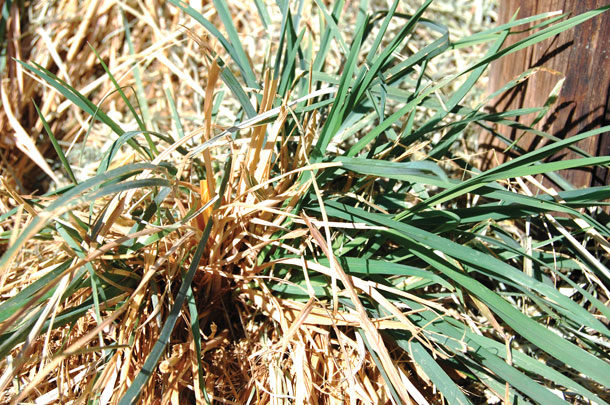There are variations to the rule, such as leaving more stubble in summer or adhering to more specific heights for different pasture species, but most management systems incorporate this rule in some way. I’m not complaining! This principle really is a key to managing good stands, and 20 years ago it was very rarely talked about. Until we started really emphasizing the rule, many producers assumed that grasses should be managed just like alfalfa and stubble height didn’t matter much. For the most part, this error has been corrected, and we all know grass needs some residual leaf material to be left behind.
There is, however, one remaining holdover from the era of managing grasses like alfalfa, and this involves late fall and winter management. Alfalfa doesn’t rely on aboveground plant tissue for energy storage at any time of year, including winter. During late fall, any alfalfa growth that was dying was thought to be useless by the plant and was therefore available to be grazed off as livestock were wintered on pastures and hayfields.
The same thought applied to grasses. After the active growing season was over, the forage that regrew after the last harvest turned brown was no longer of use to the plant – or so we thought. Therefore, in winter, grasses were grazed to the ground because winter residue wasn’t considered as important.
We know the brown “dead” forage observed during winter is not as high in forage quality as lush green growth. Why the quality difference? The nutrients are not bleached out or leached out over the winter; they are relocated by the plant in the fall. The most glaring example of this principle in action is happening outside my window right now. We have several weeping birch trees in the yard, and they are always the first to show their fall colors.
Tree leaves change to those beautiful fall colors because the chlorophyll and other compounds are broken down, and those nutrients are moved to the trunk of the tree. The tree cannot afford to just let all those nutrients in the green leaves drop to the ground and be lost. It needs to save some of those nutrients to jump-start the growing season next spring. So the golden-colored leaves on my birch trees result not so much because some new compound is manufactured in the fall foliage, but mainly because nutrients are moved out of the leaves, and the compounds which remain give us the fall colors.
Perennial forages go through the same process and the technical name for it is nutrient resorption. If you search “nutrient resorption” on the internet, you will find enough articles to last a lifetime on anything from trees to thistles. Nearly all perennial plants move nutrients (think energy) from dying leaves back to their energy storage location. This includes warm- and cool-season grasses, and yes, even alfalfa.
Unlike deciduous trees, the grass leaves stay attached to the plant and the nutrients are accessed for a longer period. Moisture is required to relocate the nutrients, so as long as the leaves and stems have any moisture at all nutrient resorption can be taking place. It is simply not the case that any forage left after a killing frost is free for the taking at that instant. It takes a bit of time for the plant to move the nutrients into storage.
The key question for a forage manager to ask is: Where this storage location is on your plants? Unlike deciduous trees, the grass leaves stay attached to the plant, and the nutrients are accessed for a longer period. For alfalfa and most other legumes, energy is stored in the roots. But back to that 3-inch rule for grasses, perennial grasses store their energy in stems near the base of the plant. This is as true in June as it is in January.
Grasses don’t have the ability to change their storage habits for the winter and shuttle nutrients to the roots for safekeeping. While it is true all grasses store energy in stems, some grasses have stems that they bury underground. We call these stems rhizomes. Some of the grasses that proliferate in tightly grazed systems include quackgrass, Kentucky bluegrass, creeping foxtail, smooth brome and reed canarygrass. Harsh grazing over winter will favor these species even in stands that had adequate residual during the growing season. More desirable species like orchardgrass and fescue can’t withstand that grazing pressure and will fade out over time.
As you read this, many of you will be at the end of the grazing season. Where do the livestock go next? Nearly all of our animals that were grazing in pastures during the growing season will be out-wintered to some degree. The decisions made regarding where you keep livestock this winter will have huge implications next year. Even if you are feeding hay, livestock will still rummage around and graze what they can find. If animals are wintered in the same spot all winter, it is likely they will graze it into the dirt. The green-up in that spot will be significantly delayed. That is OK if your forage management plan for next year takes the delay into account.
One good strategy is to use a field which will be rotated next spring as a winter-feeding area. This field can be sacrificed to save the rest. If you don’t have any fields which are going to be rotated, it is often a good idea to rotate animals even through the winter months. We aren’t talking daily moves necessarily, but keeping an eye on residual can tell you when it is time to move. Many people reel up the portable electric cross fencing in the fall and let the animals have a whole pasture at once. Just be aware, the reduced stocking density in the winter-feeding area will make tracking residuals more difficult. The forage where hay is fed will be grazed to the dirt, and forage a quarter-mile away may not be touched at all.
Another key point to consider is that during winter, there are small green leaves at the base of cool-season perennial grasses. These leaves are the beginning of the spring flush for next year. If you remove all the brown stubble, you will remove these green shoots too, which is another reason why there will be a dramatic delay in spring green-up.
The spring of 2019 revealed some of the worst winter damage we have seen in a long time. That was weather related, and we could not control it. But the self-imposed winter damage of scalping dormant grass stands is just as real. By managing what areas are grazed during winter, we can at least predict things like weak stands and delayed green-up to better manage the damage. ![]()
PHOTO: An orchardgrass plant in the fall showing a mixture of dry stems and leaves and new fall shoots. Removing any of this plant material below the 3-inch residual weakens the plant and delays spring green-up next year. Photo by Chad Hale.

-
Chad Hale
- Research and Acquisitions Manager
- Western Forage Resource
- Email Chad Hale











